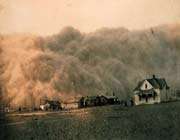The Day in History: Dust Bowl

The Dust Bowl was a series of dust storms causing major ecological and agricultural damage to American and Canadian prairie lands from 1933 to 1939, caused by severe drought conditions coupled with decades of extensive farming without crop rotation among cotton, corn and grain farmers using techniques that promoted erosion. The fertile soil of the Great Plains was exposed through removal of grass during plowing. During the drought, the soil dried out, became dust, and blew away eastwards, mostly in large black clouds. At times, the clouds blackened the sky all the way to Chicago, and much of the soil was completely lost into the Atlantic Ocean. This ecological disaster, which began as the economic effects of the Great Depression were intensifying, caused an exodus from Texas, Oklahoma, and the surrounding Great Plains, with over 500,000 Americans left homeless. Many Americans migrated west looking for work while many Canadians fled to urban areas like Toronto. Some two-thirds of farmers in "Palliser"s Triangle", in the Canadian province of Saskatchewan, had to rely on government aid to survive. This was due mainly to drought, hailstorms, and erratic weather rather than to dust storms such as those which were occurring on the U.S. Great Plains farther south. Some residents of the Plains, in especially Kansas and Oklahoma, fell prey to illnesses and death from dust pneumonia and the effects of malnutrition. OverviewThe agricultural market was particularly unstable during the 1930s, due to overproduction following World War I. National and international market forces during the war had caused farmers to push the agricultural frontier beyond its natural limits. Increasingly, marginal land that was previously considered unsuitable for use was developed to capture profits from the war.
On November 11 1933, a very strong dust storm stripped topsoil from desiccated South Dakota farmlands in just one of a series of bad dust storms that year. Then on May 11 1934, a strong two-day dust storm removed massive amounts of Great Plains topsoil in one of the worst such storms of the Dust Bowl. The dust clouds blew all the way to Chicago where filth fell like snow, dumping the equivalent of four pounds of debris per person on the city. Several days later, the same storm reached cities in the east, such as Buffalo, Boston, New York City, and Washington, D.C. That winter, red snow fell on New England.
On April 14 1935, known as "Black Sunday", twenty of the worst "Black Blizzards" occurred throughout the Dust Bowl, causing extensive damage, turning the day to night. Witnesses reported that they could not see five feet in front of them at certain points. Migrations Dust storm in Spearman, Texas, April 14 1935.
The Dust Bowl exodus was the largest migration in American history. By 1940, 2.5 million people had moved out of the Plains states; of those, 200,000 moved to California. With their land barren and homes seized in foreclosure, many farm families were forced to leave. The migration was drastic; 15% of the people living in the state of Oklahoma moved to California. Migrants also left farms in Kansas, Texas, and New Mexico, but all were generally referred to as "Okies". The plight of Dust Bowl migrants became widely known with the novel The Grapes of Wrath by John Steinbeck.
Government response
During President Franklin D. Roosevelt"s first 100 days in early 1933, governmental programs to restore the ecologic balance of the nation were implemented. The U.S. Government was to form the Soil Conservation Service, which is now the Natural Resources Conservation Service (NRCS). Influence on the artsThe human crisis was documented by photographers, musicians and authors of the time. Photographer Dorothea Lange made a name for herself while working as a photographer with the Farm Security Administration, capturing the impact of the storms on film. Independent artists like folk singer Woody Guthrie and novelist John Steinbeck both became famous for their depictions of life during the Dust Bowl of the 1930s.
Source: encyclopedia.thefreedictionary.com
Other Links:
World Asthma Day (WAD)
World Diabetes Day
World Food Day 2009
World Childrens Day 2009